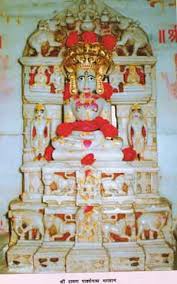Located in the historical city of Alwar, Rajasthan, the Ravan Parshwanath Jain Temple is a unique and spiritually significant Jain tirth, rooted in an extraordinary tale of devotion involving Ravana and Mandodari. This sacred place is not only admired for its ancient architecture but also revered for the miraculous origin story of its idol.
About the Mulnayak Idol
The Mulnayak idol of this temple is a 33 cm high white-coloured idol of Bhagwan Ravan Parshwanath, seated in Padmasana posture and adorned with a parikar (decorative arch). A 7-hooded serpent canopy crowns the idol, adding to its spiritual symbolism and sanctity.
Location of the Temple
The temple is located in Alwar city, Rajasthan — around 3 km from Alwar Railway Station and the city center. The area is easily accessible by road with regular bus services and private transport options.
Historical and Spiritual Significance
Alwar, once known as Alvarpur, was established by Rana Alwar in the 10th century Vikram Samvat. The legend behind this tirth sets it apart from others. According to tradition, Ravana, the mighty king of Lanka, was traveling with his wife Mandodari when they halted near Alwar for lunch.
Ravana had a strict vow: he would eat only after worshipping God. Realizing he had forgotten the idol for worship, Mandodari crafted a sand idol of Parshwanath Bhagwan and, through deep spiritual focus and recitation of the Namokar Mantra, she breathed spiritual life into it. Witnessing their unwavering devotion, the presiding deity turned the sand idol into an indestructible form.
This idol, blessed by their intense austerity and spiritual strength, came to be known as Ravan Parshwanath. The temple stood in its original form until the 15th century. Later, in V.S. 1654, Shresthi Hiranand rebuilt the temple, and a new idol was installed by Vachak Rangkalash under the guidance of Acharya Shri Jinchandrasuriji. In V.S. 1983, it was reinstalled again by Acharya Shri Vijayvallabhsurishvarji.
Temple Architecture and Artistic Beauty
This ancient temple exudes calm and spiritual strength. Though it doesn’t have the traditional pinnacles, its terraced structure and stunning idol make it a visual and spiritual delight. The beautiful face of the idol is often described as being beyond comparison – more radiant than the moon, more serene than a lotus.
Scriptures and Literary Mentions
The story and glory of Ravan Parshwanath are mentioned in several Jain texts, including:
- 365 Shri Parshvajin Naammala
- Shri Ravan Parshwanath ka Faag
- Shri Sankheswar Parshvanath ka Chand
- Parshva Ashtotar Naam Stavan
- Shri Godi Parshvanath Stavan
- Tirthmala
- 108 Naamgarbhit Shri Parshvanath Stavan
- Shri Parshvanath Chaityaparipati
- Shri Ravan Parshvanath Stotra
There is also a replica idol of Ravan Parshwanath at Jiravala Tirth.
Travel Guidelines
- Nearest Railway Station: Alwar Railway Station – 3 km away
- City Access: The city center is 3 km from the temple
- Facilities: Dharamshala and Bhojanshala are available for pilgrims
- Transport: Well-connected by bus and private taxis
Temple Trust Information
Shri Ravan Parshwanath Shwetambar Jain Tirth
Birbal Ka Mohalla, Post: Alwar – 301001, Rajasthan, India
Frequently Asked Questions (FAQs)
Who is Ravan Parshwanath?
Ravan Parshwanath is a form of Bhagwan Parshwanath worshipped by Ravana and Mandodari. According to legend, Mandodari created the idol from sand and spiritually enlivened it with devotion, which turned into an eternal form through divine blessing.
Where is the Ravan Parshwanath Temple located?
It is located in Alwar, Rajasthan, just 3 km from the Alwar Railway Station and city center.
What is the story behind Ravan Parshwanath?
Ravana had vowed to eat only after worship. When he forgot to carry an idol during his journey, his wife Mandodari created one out of sand. Through her deep devotion and spiritual power, the idol was blessed and became immortal. It has been revered ever since as “Ravan Parshwanath.”
When was the current idol installed?
The current idol was first installed in V.S. 1654 and later reinstalled in V.S. 1983 by revered Jain Acharyas.
Does the temple follow traditional Jain architecture?
The temple is built with a flat terrace and no pinnacles, which is unique, but its spiritual aura and the beauty of the idol surpass architectural expectations.
Are facilities available for pilgrims?
Yes, there are Dharamshala and Bhojanshala facilities for visitors.
Are there any other temples in the vicinity?
No, this temple stands as the primary tirth in the area without any other Jain temples nearby.
For an extensive list of Parshwanath temples and their significance, visit the 108 Parshwanath Names List.
